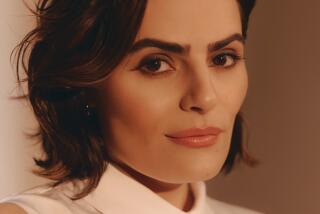A Close Look at Reindeer : Some Are Onery, Some Have Great Personalities
- Share via
One night at Knott’s Berry Farm two Christmases ago, my 3-year-old niece, Erin Cunningham, and I had gotten off by ourselves, leaving our group to other amusements. The music was cheerful and jingly, and the Southern California weather was sufficiently in keeping with the holiday spirit to oblige us with an unseasonal cold that condensed our breath into short-lived, wintry fogs. Suddenly, my niece’s eyes opened wide. I looked where she pointed and saw a small animal with large antlers. Its thick hair was brown and white, and it wore a bell-laden halter of red-velvet ribbon. Erin’s awe-struck expression reflected three Christmases’ worth of carols and poems and pictures of these creatures in carefree flight. Her jaw dropped, and she said, quietly, “It’s Rudolph.”
This season, a small herd of eight male and one female reindeer can be seen at Disneyland until Jan. 4, in a pen at Big Thunder Ranch, a livestock area that opened in June. “A reindeer is essentially a domesticated caribou,” says ranch supervisor Debbie Sligh as we stand at the corral fence watching the herd, most of which are small, about four feet high at the shoulder. “They’re real nice animals,” she says. “They’re smart and tremendously curious, though they’re skittish.” Just then, the Disneyland Railroad train comes by, and the reindeer look up. When the conductor blasts his shrill steam whistle, it causes a stampede across the corral. After the train chugs out of hearing, the reindeer seem to relax, and soon the whole herd inches nearer to us.
As they move, there is an odd, syncopated clicking sound. “Their ankles make that noise when they walk,” Sligh says. “The one in the lead is the female; she’s the only one with clean antlers.” Reindeers’ antlers will grow to be about three feet high and two feet wide. They are different from horns, Sligh says, in that “horns are permanent; antlers fall off and re-grow annually. And only in reindeer do both sexes grow antlers, which--in composition nearly indistinguishable from human bone--grow a thin, furry skin, called ‘velvet.’ ” Every year, this covering is rubbed off by the animals; females generally take care of this chore before the males.
The female now walks right up to the fence. I touch the long, coarse hair on her flank. She backs away but only just out of reach.
I ask where the animals came from. Sligh looks uncomfortable. “I’m supposed to tell everyone that they flew here from the North Pole,” she says.
The herd is from the north, it’s true, but from a 20-acre reindeer-rental outfit in Redmond, Ore., called Operation Santa Claus. Around Christmastime every year, manager Mike Gillaspie trucks teams of reindeer all over the country to participate in parades and sleigh rides. Reindeer look small, he says, “but they’re stocky and strong; they can pull four to five times their own weight. The bulls can get up over 500 pounds.” Sometimes, he cautions, people who claim to be displaying reindeer are actually showing European fallow deer; these are small and white, and the females have no antlers.
In the wild, Gillaspie says, reindeer live only five to seven years, but in the gentler conditions of captivity they’ll get to be 10 to 13. Are the more than 100 reindeer kept in Oregon all as gentle as the ones at Disneyland seem? “They’re not particularly aggressive, except in rutting season, when the males will go at each other,” Gillaspie says. “They’re like people: Some are ornery; some have great personalities.”
In colder, more northern climates, as in Alaska, the reindeer is used much as early North Americans used the buffalo. The Lapps domesticate them, keeping them as pets and raising them for their milk, meat and hides, from which are made clothing, boots and tents. The Lapps also use them as pack and draft animals. In Siberia, reindeer are ridden like horses across the frozen steppes. Originally from the Arctic Circle, they are excellent swimmers, as animals that migrate across many northern rivers would have to be. Their swimming ability stems, in part, from the fact that their hair is hollow and contains air.
Besides being rented out to brighten childrens’ holidays, reindeer are used in medical research. At Washington State University, at Pullman, Jarrett Newbrey has been working on a pilot study of osteoporosis--the bone-weakening disease that so painfully afflicts the aged, especially post-menopausal women. Reindeer bone, Newbrey says, becomes “osteoporotic” (meaning it loses bone mass) as calcium is leached from it to produce the antlers each year. The deers’ bones recover their density, however, unlike the process in humans who have osteoporosis. Early indications show a correlation between osteoporosis and a drop in estrogen levels. Discovering what controls the mechanism of bone recovery in the reindeer, Newbrey says, will provide insight into treating the human disorder.
Newbrey is applying for a grant from the National Institutes of Health for further study. Should he get the funds, it is possible that reindeer will bring humans a different kind of present one year.
More to Read
Sign up for The Wild
We’ll help you find the best places to hike, bike and run, as well as the perfect silent spots for meditation and yoga.
You may occasionally receive promotional content from the Los Angeles Times.






